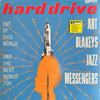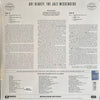



Art Blakey & The Jazz Messengers - Hard Drive (DMM)
Drums – Art Blakey [click here to see more vinyl featuring Art Blakey]
Tenor Saxophone – Johnny Griffin [click here to see more vinyl featuring Johnny Griffin]
Trumpet – Bill Hardman
Bass – Spanky de Brest
Piano – Junior Mance (A1-2, A4, B1-3), Sam Dockery (A3)
Written by Jimmy Heath (A1, B1), Johnny Griffin (A2, B2), Bill Hardman (A3-4), Leon Mitchell (B3)
1 LP, standard sleeve printed by GZ Media (Czechia)
Original analog Master tape: YES
Heavy Press : 180g
Record color : black
Speed : 33 RPM
Size : 12'’
Stereo
Studio
Record Press : Precision Record Pressing (Canada)
Label: Bethlelem
Original Label : Bethlelem
Recorded in New York October 9 (A3) & October 11 (all others tracks), 1957
Produced by Lee Kraft
New 2022 Direct Metal Mastering
Liner Notes by Nat Hentoff
Originally released in December 1957
Reissued in January 2023
Tracks :
Side A:
- For Minors Only
- Right Down Front
- Deo-X
- Sweet Sakeena
Side B:
- For Miles and Miles
- Krafty
- Late Spring
Reviews :
“The final recording by the second version of Art Blakey's Jazz Messengers features trumpeter Bill Hardman, tenor saxophonist Johnny Griffin, either Junior Mance or Sam Dockery on piano and bassist Spanky DeBrest along with leader/drummer Blakey performing four group originals, two Jimmy Heath compositions and the obscure "Late Spring." Although this was not the most famous edition of The Messengers, it set a standard that its successors would uphold to, training its members to be bandleaders in their own right. The music on this album is typical hard bop of the period, well played and full of enthusiasm and fire.” AllMusic Review by Scott Yanow
Direct Metal Mastering
In Direct Metal Mastering, the cutting lathe engraves the audio signal directly onto a copper-plated master disc, instead of engraving the groove into a lacquer-coated aluminum disc.
The direct metal mastering technology addresses the lacquer mastering technology's issue of pre-echoes during record play, caused by the cutting stylus unintentionally transferring some of the subsequent groove wall's impulse signal into the previous groove wall. In particular, a quiet passage followed by a loud sound often clearly revealed a faint pre-echo of the loud sound occurring 1.8 seconds ahead of time (the duration of one revolution at 33 rpm). This problem could also appear as post-echo, 1.8 seconds after a peak in volume.
Another improvement is noise reduction. The lacquer mastering method bears a higher risk of adding unwanted random noise to the recording, caused by the enclosure of small dust particles when spraying the silvering on the lacquer master, which is the necessary first step of the electroplating process for reproduction of the master disc. As the DMM master disc is already made of metal (copper), this step is not required, and its faults are avoided.
With the groove being cut straight into a metal foil, this removed a number of plating stages in the manufacturing process. This gave rise to more upper frequency levels and less surface noise. Additionally, groove pre-echo problems are significantly diminished. Bass is typically tight and well defined, even described as more accurate than the fat, mushy sound of lacquered vinyl pressings.
Ratings :
AllMusic: 3 / 5 , Discogs : 4.23 / 5


